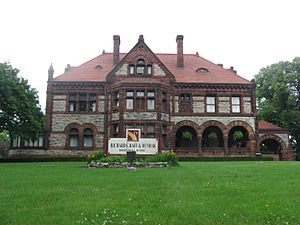Asa S. Bushnell facts for kids
Quick facts for kids
Asa Smith Bushnell
|
|
|---|---|
 |
|
| 40th Governor of Ohio | |
| In office January 13, 1896 – January 8, 1900 |
|
| Lieutenant | Asa W. Jones |
| Preceded by | William McKinley |
| Succeeded by | George K. Nash |
| Personal details | |
| Born | September 16, 1834 Rome, New York, U.S. |
| Died | January 15, 1904 (aged 69) Columbus, Ohio, U.S. |
| Resting place | Ferncliff Cemetery, Springfield, Ohio |
| Political party | Republican |
| Spouse | Ellen Ludlow |
| Children | 3 |
| Signature | |
| Military service | |
| Allegiance | United States of America |
| Branch/service | Union Army |
| Years of service | 1864 |
| Rank | Captain |
| Unit | 152nd Ohio Infantry |
| Battles/wars | American Civil War |
Asa Smith Bushnell I (born September 16, 1834 – died January 15, 1904) was an American politician from Ohio. He was a member of the Republican Party. Bushnell served as the 40th governor of Ohio. Before becoming governor, he was a successful businessman. He led a company that later became part of International Harvester, a big farm equipment maker. He also led the Springfield Gas Company and the First National Bank of Springfield.
Contents
Asa Bushnell's Life and Career
Early Life and Military Service
Asa Bushnell was born in Rome, New York. When he was 17, he moved to Springfield, Ohio. During the American Civil War, he helped create a group of soldiers. He served as a captain from May to September 1864. This was for the 152nd Ohio Infantry regiment.
Political and Business Roles
Bushnell was a very active person. In 1884, he was a Presidential elector. This meant he helped choose the President of the United States. He was also a leader in business. In 1885, he became the head of the Republican Party in Ohio. He took over as governor after William McKinley. Bushnell served two terms as governor, from 1896 to 1900.
Fighting Monopolies: The Valentine Anti-Trust Act
During Governor Bushnell's time, Ohio was a leader in fighting against "trusts." Trusts were big groups of companies that tried to control a whole industry. They would work together to stop competition. This often meant they could raise prices very high for customers.
Bushnell signed the Valentine Anti-Trust Act into law. This law made it illegal for companies to agree on prices. It also stopped them from limiting how much they produced. These actions helped businesses make more money, but they hurt regular people. Bushnell's legal team also went after the Standard Oil Company. This company was known for its huge control over the oil business.
Later, a U.S. Senator from Ohio, John Sherman, created the Sherman Antitrust Act in 1890. This was the first big step by the U.S. government to break up these powerful monopolies. It aimed to make business fairer for everyone.
Governor Bushnell's Death
In January 1904, Bushnell traveled from his home in Springfield. He went to Columbus for the inauguration of the new Governor, Myron T. Herrick. After the ceremony, he became very ill on his way home. He passed away four days later in a Columbus hospital. He was buried in Ferncliff Cemetery in Springfield.
Bushnell's Family and Home
Family Life
Asa Bushnell married Ellen Ludlow on September 17, 1857. They had two daughters and one son. He was also a member of several groups. These included the Masons and the Grand Army of the Republic. He was also part of the Episcopal Church.
His Springfield Home
Asa and Ellen Bushnell built a large house in Springfield. It was designed in a style called Richardson Romanesque. This style uses strong, heavy stone and round arches. The house was designed by the firm of a famous architect, Henry Hobson Richardson. This happened soon after Richardson passed away.
Bushnell's business partners had also hired Richardson to design their homes. These included the Warder Mansion and the John J. Glessner House. The Glessner House is seen as one of Richardson's best designs.
The Bushnell House is now part of the East High Street Historic District in Springfield. This district is listed on the National Register of Historic Places. This means it is an important historical site.


